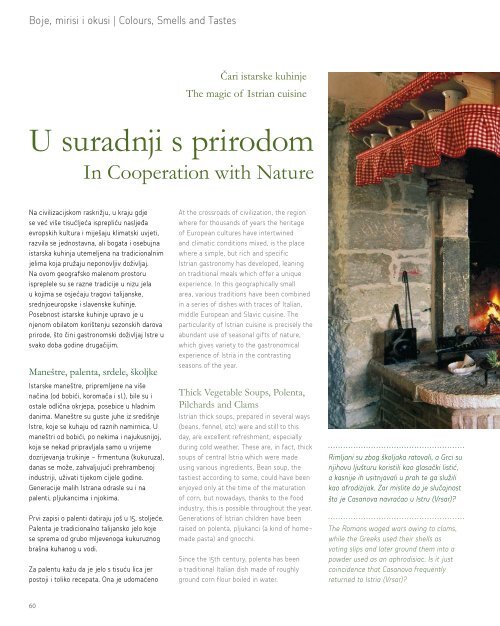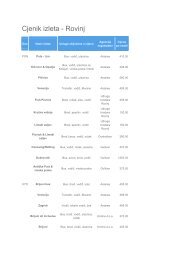Create successful ePaper yourself
Turn your PDF publications into a flip-book with our unique Google optimized e-Paper software.
Boje, mirisi i okusi | Colours, Smells and Tastes<br />
Piše | Text by: Viljam Cvek<br />
Čari istarske kuhinje<br />
The magic of Istrian cuisine<br />
U suradnji s prirodom<br />
In Cooperation with Nature<br />
Na civilizacijskom raskrižju, u kraju gdje<br />
se već više tisućljeća isprepliću nasljeđa<br />
evropskih kultura i miješaju klimatski uvjeti,<br />
razvila se jednostavna, ali bogata i osebujna<br />
istarska kuhinja utemeljena na tradicionalnim<br />
jelima koja pružaju neponovljiv doživljaj.<br />
Na ovom geografsko malenom prostoru<br />
ispreplele su se razne tradicije u nizu jela<br />
u kojima se osjećaju tragovi talijanske,<br />
srednjoeuropske i slavenske kuhinje.<br />
Posebnost istarske kuhinje upravo je u<br />
njenom obilatom korištenju sezonskih darova<br />
prirode, što čini gastronomski doživljaj Istre u<br />
svako doba godine drugačijim.<br />
Maneštre, palenta, srdele, školjke<br />
At the crossroads of civilization, the region<br />
where for thousands of years the heritage<br />
of European cultures have intertwined<br />
and climatic conditions mixed, is the place<br />
where a simple, but rich and specific<br />
Istrian gastronomy has developed, leaning<br />
on traditional meals which offer a unique<br />
experience. In this geographically small<br />
area, various traditions have been combined<br />
in a series of dishes with traces of Italian,<br />
middle European and Slavic cuisine. The<br />
particularity of Istrian cuisine is precisely the<br />
abundant use of seasonal gifts of nature,<br />
which gives variety to the gastronomical<br />
experience of Istria in the contrasting<br />
seasons of the year.<br />
Istarske maneštre, pripremljene na više<br />
načina (od bobići, koromača i sl.), bile su i<br />
ostale odlična okrjepa, posebice u hladnim<br />
danima. Maneštre su guste juhe iz središnje<br />
Istre, koje se kuhaju od raznih namirnica. U<br />
maneštri od bobići, po nekima i najukusnijoj,<br />
koja se nekad pripravljala samo u vrijeme<br />
dozrijevanja trukinje - frmentuna (kukuruza),<br />
danas se može, zahvaljujući prehrambenoj<br />
industriji, uživati tijekom cijele godine.<br />
Generacije malih Istrana odrasle su i na<br />
palenti, pljukancima i njokima.<br />
Prvi zapisi o palenti datiraju još u 15. stoljeće.<br />
Palenta je tradicionalno talijansko jelo koje<br />
se sprema od grubo mljevenoga kukuruznog<br />
brašna kuhanog u vodi.<br />
Za palentu kažu da je jelo s tisuću lica jer<br />
postoji i toliko recepata. Ona je udomaćeno<br />
Thick Vegetable Soups, Polenta,<br />
Pilchards and Clams<br />
Istrian thick soups, prepared in several ways<br />
(beans, fennel, etc) were and still to this<br />
day, are excellent refreshment, especially<br />
during cold weather. These are, in fact, thick<br />
soups of central Istria which were made<br />
using various ingredients. Bean soup, the<br />
tastiest according to some, could have been<br />
enjoyed only at the time of the maturation<br />
of corn, but nowadays, thanks to the food<br />
industry, this is possible throughout the year.<br />
Generations of Istrian children have been<br />
raised on polenta, pljukanci (a kind of homemade<br />
pasta) and gnocchi.<br />
Since the 15th century, polenta has been<br />
a traditional Italian dish made of roughly<br />
ground corn flour boiled in water.<br />
Rimljani su zbog školjaka ratovali, a Grci su<br />
njihovu ljušturu koristili kao glasački listić,<br />
a kasnije ih usitnjavali u prah te ga služili<br />
kao afrodizijak. Zar mislite da je slučajnost<br />
što je Casanova navraćao u Istru (Vrsar)?<br />
The Romans waged wars owing to clams,<br />
while the Greeks used their shells as<br />
voting slips and later ground them into a<br />
powder used as an aphrodisiac. Is it just<br />
coincidence that Casanova frequently<br />
returned to Istria (Vrsar)?<br />
jelo naših predaka koje se koristi u bezbroj kombinacija: uz meso, ribu,<br />
ili kao zamjena za kruh.<br />
Bogatstvo riba, rakova i školjkaša u istarskome akvatoriju ogleda se u<br />
istarskoj kuhinji kroz velik broj jela koja se svakodnevno pripremaju.<br />
Među njima su jela poput friganih girica ili srdela, ribljih juha,<br />
brudeta s palentom, jela od dagnji i rakovica pa sve do svježe ribe na<br />
gradelama ili školjki kao hrane bogova.<br />
Srdela je jedna od rijetkih namirnica za koje ne vrijedi pravilo - što<br />
skuplje to bolje. To je najjeftinija riba, ali spravljena na niz načina<br />
može biti vrhunska delikatesa. Usto, srdela je i vrlo je zdrava. Ona,<br />
naime, pripada plavoj ribi koja je nutritivno najvrjednija jer je bogata<br />
Polenta is said to be a dish with a thousand faces because there are<br />
so many recipes. It is a traditional meal of our ancestors used in a<br />
number of combinations: meat, fish, or perhaps as a substitute for<br />
bread.<br />
The abundance of fish, crabs and clams in the Istrian local waters is<br />
reflected in Istrian cuisine in a large number of dishes which used<br />
to be prepared daily. From the simplest ones, such as fried picarels<br />
and pilchards, to fish soups, fish stews with polenta, dishes made of<br />
mussels, sea-spiders to grilled fresh fish or clams as the food of the<br />
gods.<br />
The pilchard is one of the rare ingredients to which the rule - the<br />
more expensive, the better - does not apply. This is the cheapest<br />
60<br />
61

















